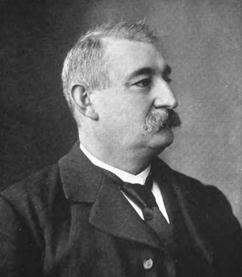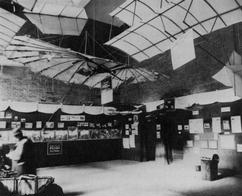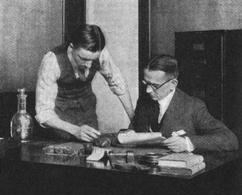|

 Up
Up 
 Politics
and
Politics
and
Patents 
(You are here.)
 Down
Down




  Need
to Need
to
find your
bearings?
Try
these
navigation aids:
If
this is your first
visit, please stop by:
Something
to share?
Please:



|
|
Available in Française, Español, Português, Deutsch, Россию,
中文,
日本, and others.
 he
Wrights first tested the aviation market in January 1905, writing to their
congressman Robert M. Nevin and offering either to sell an airplane to the
government or to furnish information, experience, and license to use their
patents so the government could build planes of their own. Nevin knew that
the War Department would be less than receptive to the offer, owing
to their recent embarrassment over the failure of Langley's "Great
Aerodrome." He had suggested that he take the Wright's letter to
President Roosevelt personally, hoping that his recommendation would
convince Roosevelt the Wrights had succeeded where Langley had
failed. Nevin would then present the Wright offer to the War
Department with Roosevelt's endorsement. he
Wrights first tested the aviation market in January 1905, writing to their
congressman Robert M. Nevin and offering either to sell an airplane to the
government or to furnish information, experience, and license to use their
patents so the government could build planes of their own. Nevin knew that
the War Department would be less than receptive to the offer, owing
to their recent embarrassment over the failure of Langley's "Great
Aerodrome." He had suggested that he take the Wright's letter to
President Roosevelt personally, hoping that his recommendation would
convince Roosevelt the Wrights had succeeded where Langley had
failed. Nevin would then present the Wright offer to the War
Department with Roosevelt's endorsement.
But Nevin was out of his office when Wilbur's letter
arrived. Knowing nothing of Nevin's plan to walk the letter through
the Washington DC bureaucracy, his office staff forwarded it to the United States Army Board of Ordinance and
Fortification. Their response to the Wrights was chilly: "…the Board has found it
necessary to decline to make allotments for experimental development of…mechanical
flight." The Wrights tried again in October, writing directly to the
Secretary of War, William Howard Taft, but the answer was the same.
They also wrote the War Office in Great Britain, and initially the
British seemed interested. But they quickly reached a deadlock. To protect
their patent, the Wrights insisted that any potential buyer sign a
contract before they would make demonstration flights. If their
flying machine didn't do everything they said it would do, they would
release the buyer from the contract. It sounded fair and reasonable to the
Wright brothers, but their demands made government bureaucrats nervous.
The British War Office declared they would not deal with the Wrights until
they flew for a British representative, and there the negotiations
stalled.
Turning to France, they were initially met with disbelief and derision,
led by members of the French Aero-Club de France. If the Wrights had
actually flown for 25 miles, why wasn't the news splashed all over the
American newspapers? The French even dispatched representatives to Dayton
to investigate, then dismissed their reports when these representatives
asserted that the Wrights had done all that they had claimed. There were
some who believed, however, and the French War Ministry began to negotiate
a contract with the Wrights. But they wavered before the Wrights' $200,000
asking price, and the negotiations collapsed in the spring of 1906.
Things looked bleak, but they were about to take a turn for the better.
On 14 November 1905,
Charles Manly reported to the newly formed Aero Club of America on
the Wright's test flights of 1904 and 1905. Apparently, he had either
surreptitiously witnessed some of these flights himself, or he was privy
to the reports that the Wrights had sent to a very few of their friends.
The Aero Club responded by inviting the Wrights to participate in an
exhibition they were producing mid-January 1906 at the 69th Regiment
Armory in New York City. The Wright sent photographs and information
on their glider flights, along with the crankshaft and flywheel of the
1903 engine that had been damaged after the last flight on 17 December
1903. During the exhibition, Scientific American published an
editorial, "The Wright Airplane and its Fabled Performance," which
all but called Wilbur and Orville liars. It pretty well summed up
the skepticism of the country. But Aero Club member William J.
Hammer was convinced that the Wright claims needed to be
investigated. After the exhibition, he traveled to Dayton, Ohio and
met with Orville a Wilbur personally. He came away convinced that
the Wright brothers had done what they claimed and went about
setting the record straight. In early March of 1906, the Aero Club
of America adopted a resolution that endorsed and congratulated the
Wright brothers on their achievement. They sent this to the press,
along with a letter from the Wrights that described their 1904/1904
test flights. It was the Wright's first public announcement of their
success in developing a practical airplane. This spurred
Scientific American to conduct its own investigation and on 7
April 1906, the magazine told its readers, "There is no doubt
whatever that these able experimenters deserve the highest credit
for having perfected the first flying machine of the
heavier-than-air type which has ever flown successfully and at the
same time carried a man."
On 22 May 1906, the Wrights got more good news. The United States
of America formally granted Patent Number 821,393 to O. & W. Wright of Dayton, Ohio for a
Flying Machine. With their hard work protect by a patent, the Wrights felt
they could safely demonstrate their invention in public. In Their Own
Words Patent No. 821,343
-- The complete text and illustrations of the grandfather patent of
the airplane.
|

Ohio Representative Robert M. Nevin.

The Aero Club of America's Exhibition of Aeronautical Apparatus
featured gliders, kites, balloons, and dirigibles that were flown prior
to 1906, along with photographs of aeronautical experiments and test
flights from all over the country. The Wright's 1903 crankshaft and
flywheel rests on a stand at the lower right.

The Wright brothers applied to the US Patent Office
in 1903. The patent was awarded in 1906 and in 1913 is was adjudicated to
be the "grandfather" patent of the airplane.

The patent was written by the Wright's attorney,
Harry A. Toumlin, Sr. (seated). Toumlin also secured foreign patents for
the Wrights.
|